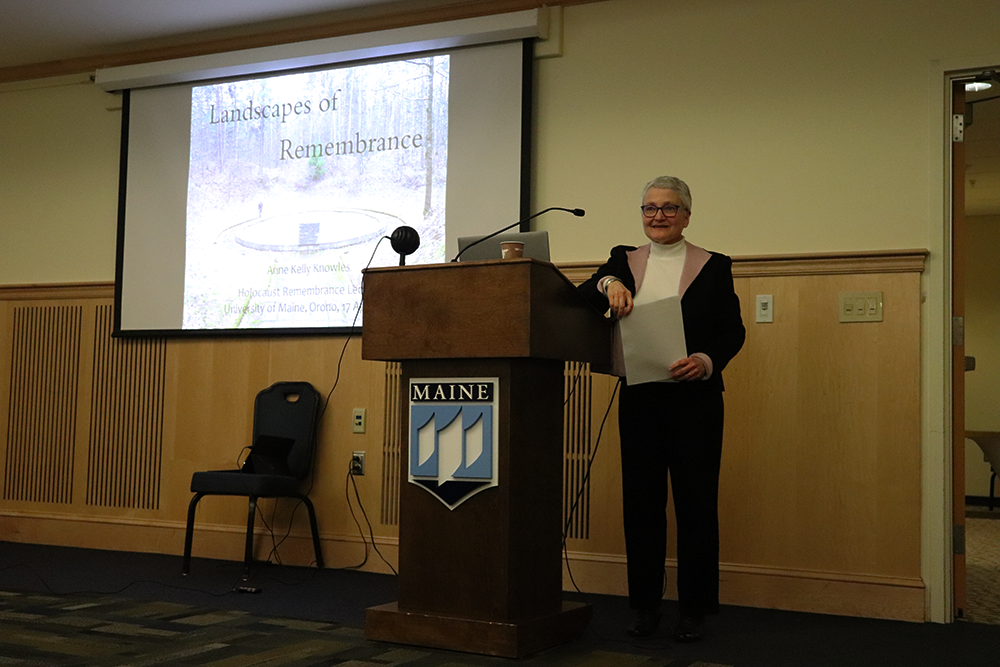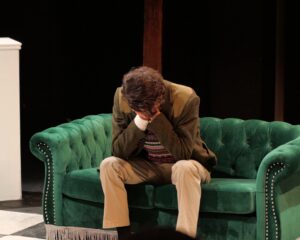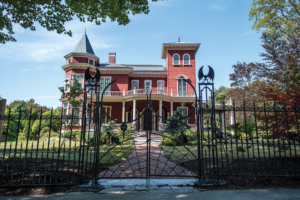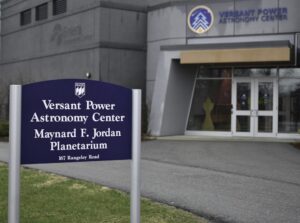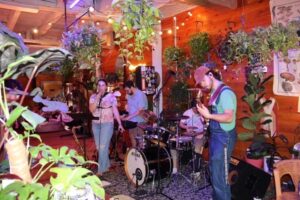University of Maine History Professor Anne Kelly Knowles presented her project “Landscapes of Remembrance” on Monday April 17, 2023 at the Wells Conference Center. The lecture occurred on Yom HaShoah, also known as Holocaust Remembrance Day. The project focused on how landscapes and memorials can help us visualize, understand and remember the Holocaust. Knowles’ presentation highlighted important details about landscapes such as their locations, their architecture and their ever-changing nature.
“I’ve been studying the Holocaust for 15 years, but only this semester began to focus on the landscapes of remembrance. The lecture was a first step in what will take some time to understand well,” Knowles said.
Her lecture contained five separate sections regarding landscapes and memorials. These included sacralized fossil landscapes of SS concentration camps, artistic renderings of absence, rupture and void, digital reconstruction of erased Jewish landscapes, landscape as evidence and archive and sites that promote personal connection through remembrance.
In her lecture, Knowles highlighted that changing landscapes often result in changing perceptions and understandings. She cited landscapes at Auschwitz as an example.
“Auschwitz was initially regarded with horror, a place to be avoided,” Knowles stated. “It did not become a major tourist site until the 1980s and 1990s, with the rise of ‘dark tourism,’ a term used to describe tours organized for people interested in the Holocaust” Knowles said.
However, Knowles noted that changing landscapes can also be psychologically challenging for those who have strong emotions and memories tethered to them.
“…One’s memories are anchored in places,” Knowles said
“Being there again years later, or being suddenly reminded of a place, can bring memories flooding back. This is also why it can be very disorienting and even distressing when a place changes; it can seem like an erasure of your sense of self, because it displaces your memories.”
Many memorials featured in Knowles’ lecture were intentionally designed to invoke intense reflection. Peter Eisenman’s Memorial to the Murdered Jews of Europe, located in Berlin, Germany, was one of them. Containing over 2,000 concrete slabs of varying heights, the memorial looks as though it may feel disorienting, unsettling or overwhelming.
“Most professionally designed memorials are created very carefully to have a particular effect on viewers,” Knowles said. “The effects that designers, architects, sculptors, and other creators strive to achieve change over time, or they can be idiosyncratic.”
Knowles specifically cited the U.S. Holocaust Memorial Museum in Washington, D.C. as one example of an intentionally designed memorial space.
“Elie Wiesel is reported to have told the architect of the U.S. Holocaust Memorial Museum in Washington, DC, that it should unsettle and disturb people, because we should never become comfortable with the Holocaust,” Knowles said. “The building’s unexpected angles, lack of ground-floor windows, prison-like elevators, and other features definitely resist making one feel at ease.”
Another memorial Knowles highlighted, which is unsettling in different ways, is Micha Ullman’s Empty Library, located in Berlin, Germany. The memorial is within the ground — a glass slab revealing white, empty bookshelves. It was constructed to remember the 1933 book burning by students and professors of the Nazi German Student Union.
Another facet of Knowles’ project involved digitally reconstructing Jewish buildings destroyed in the war. She was inspired by Omer Bartov’s book “Anatonmy of a Genocide” to complete this task, and is continuously inspired by others in her studies.
“I am constantly inspired by writers and artists who seek to understand the Holocaust,” Knowles said. “The subject is very demanding emotionally and psychologically, but the best work that emerges from engaging with it is moving, humane, often graceful, and provides great insight into human nature.”
A memorial Knowles found particularly powerful is the Memorial at Belzec in Poland, where over 500,000 Jewish people were killed in World War II. The memorial contains a walkway through a vast expanse of rock while disorderly, rusted wire acts as a sort of fence.
“…I do admire memorials that have been deeply designed, really thought through, and that acknowledge and somehow incorporate the landscape,” Knowles said.
Professor Anne Knowles’ lecture “Landscapes of Remembrance” can be viewed through the UMaine’s Judaic Studies Youtube channel at https://www.youtube.com/watch?v=pI0WvkqOzpc.
